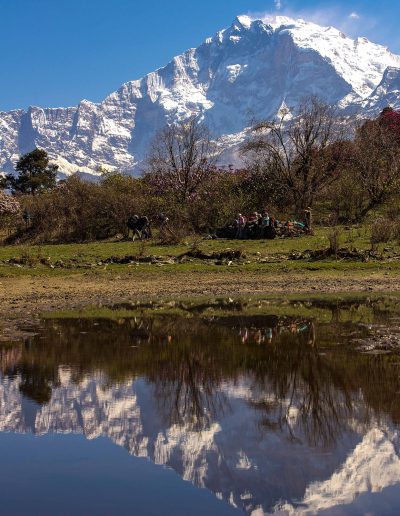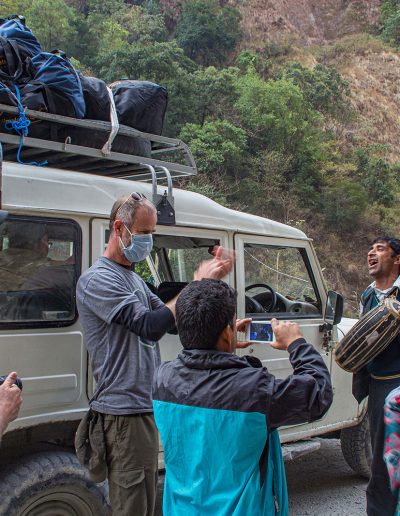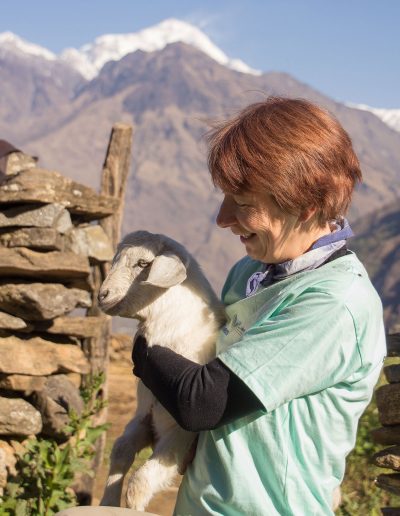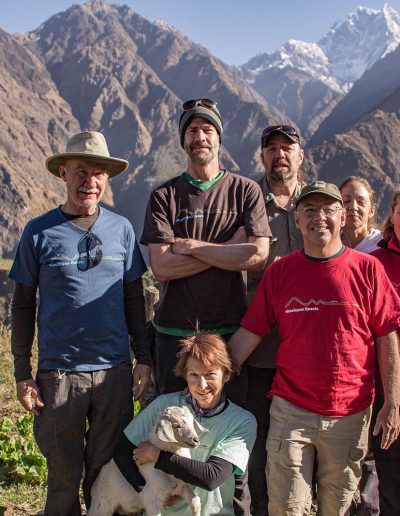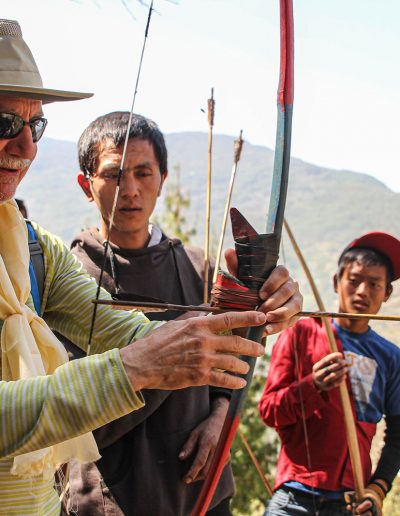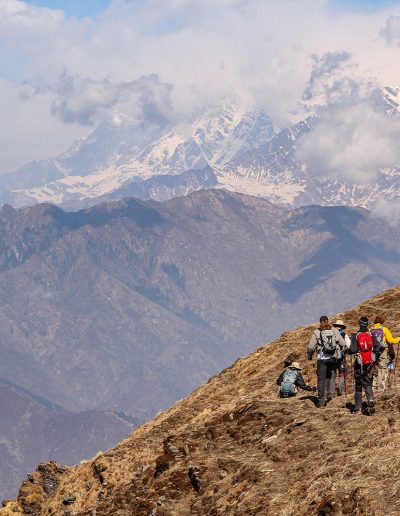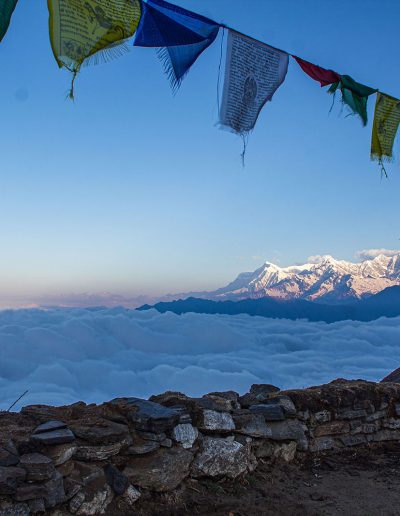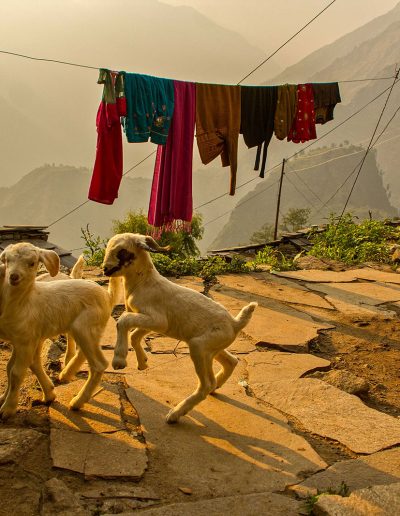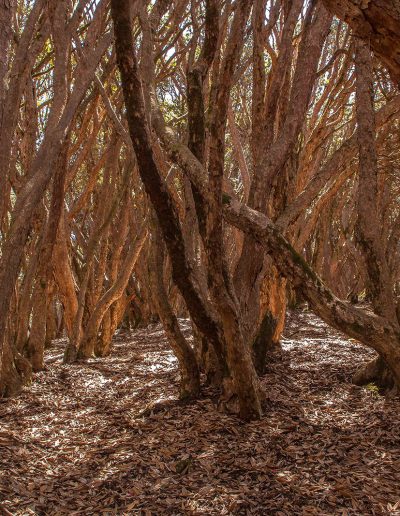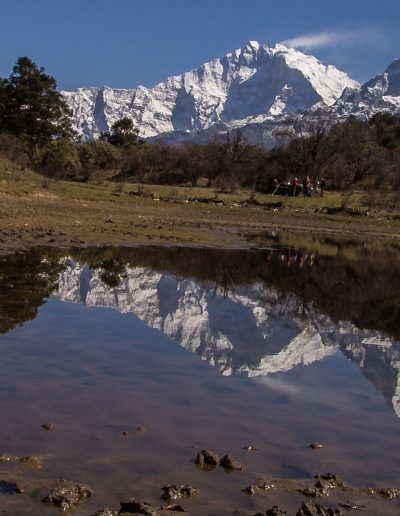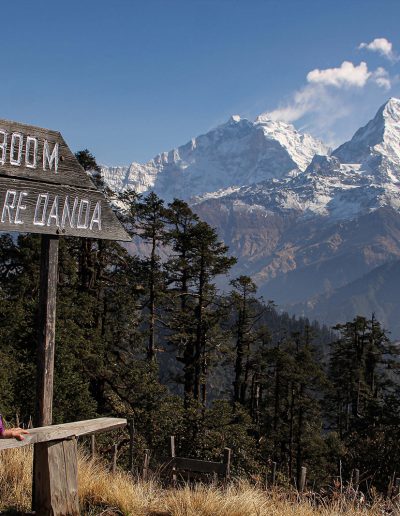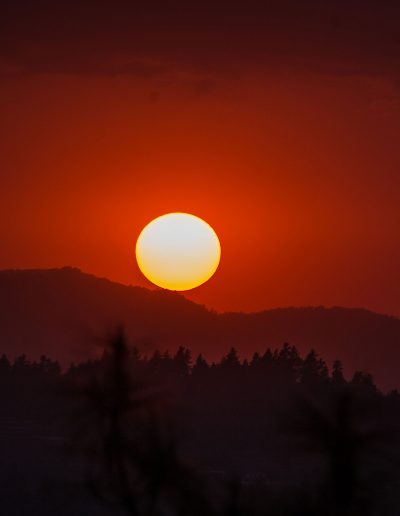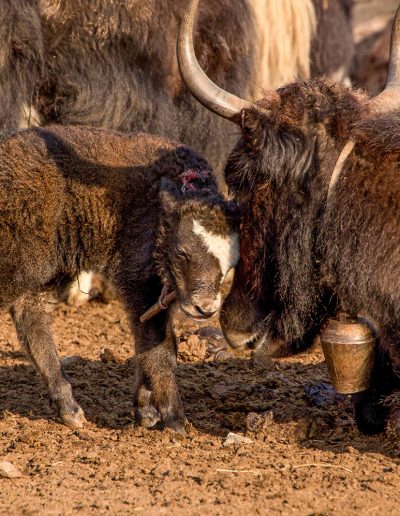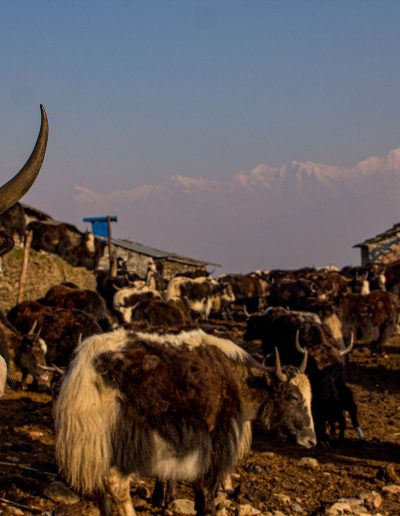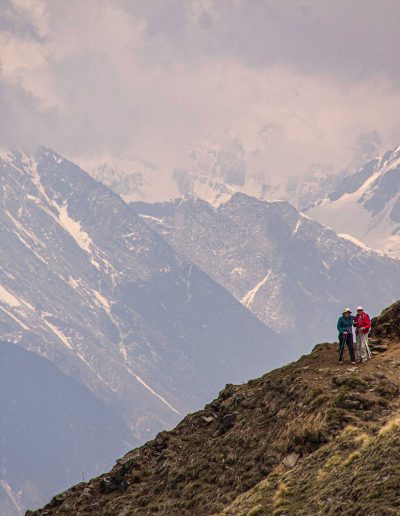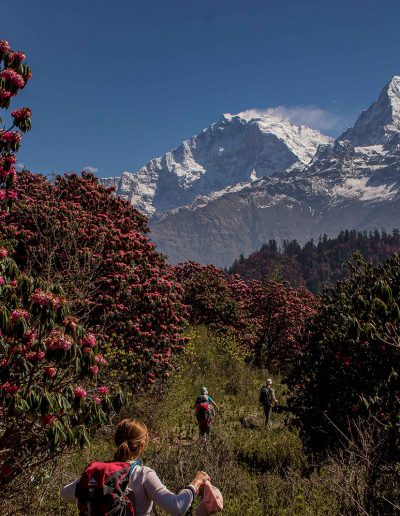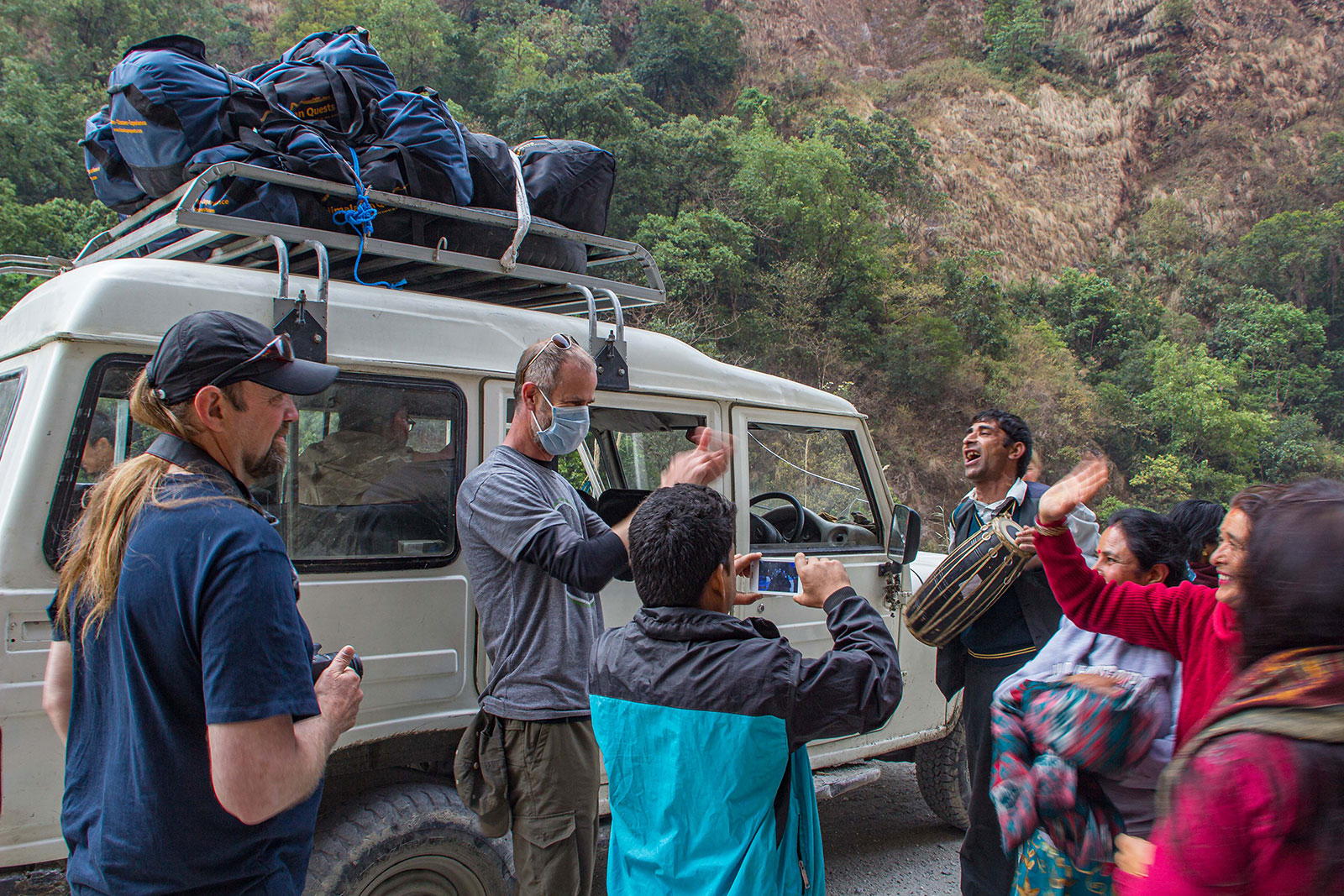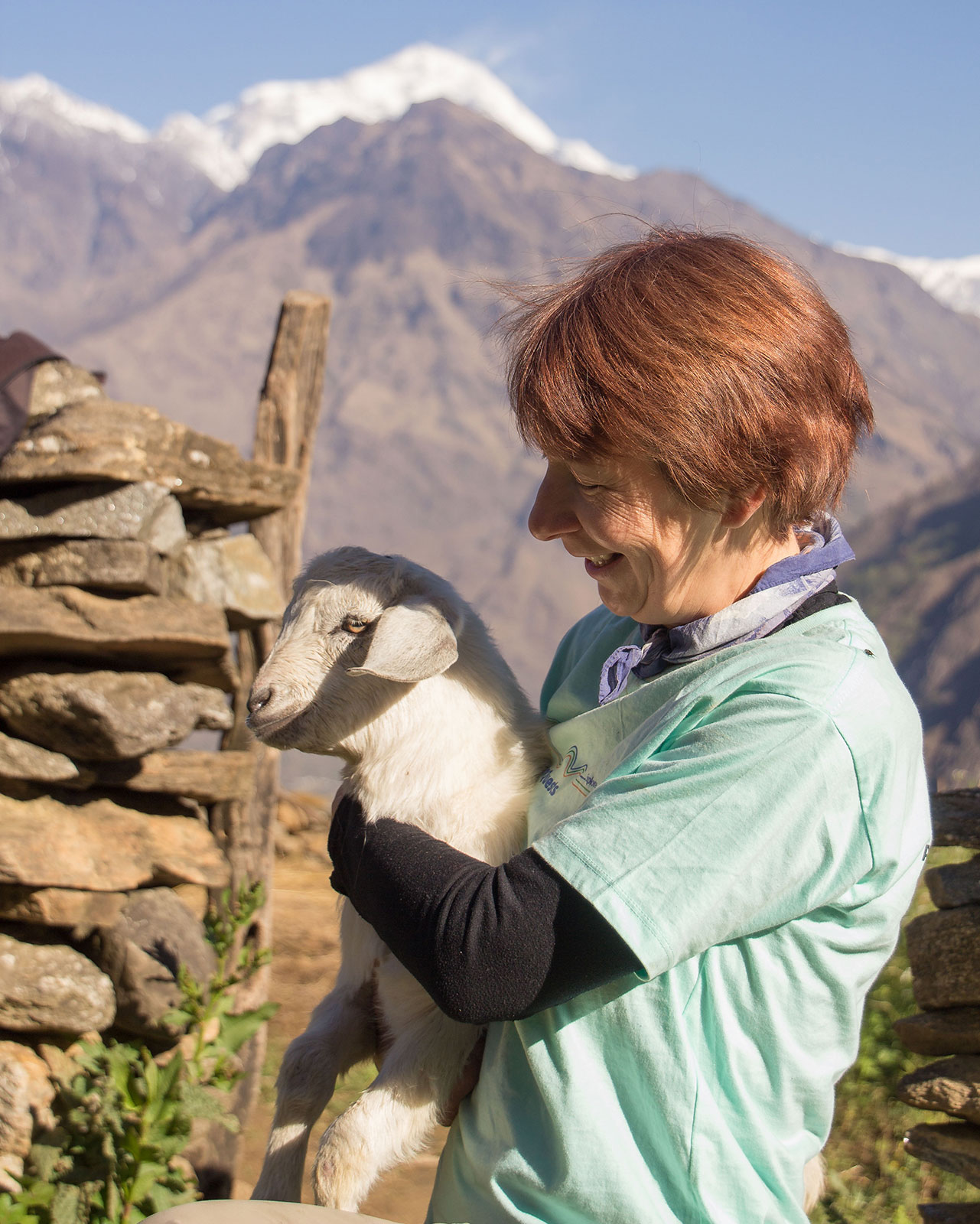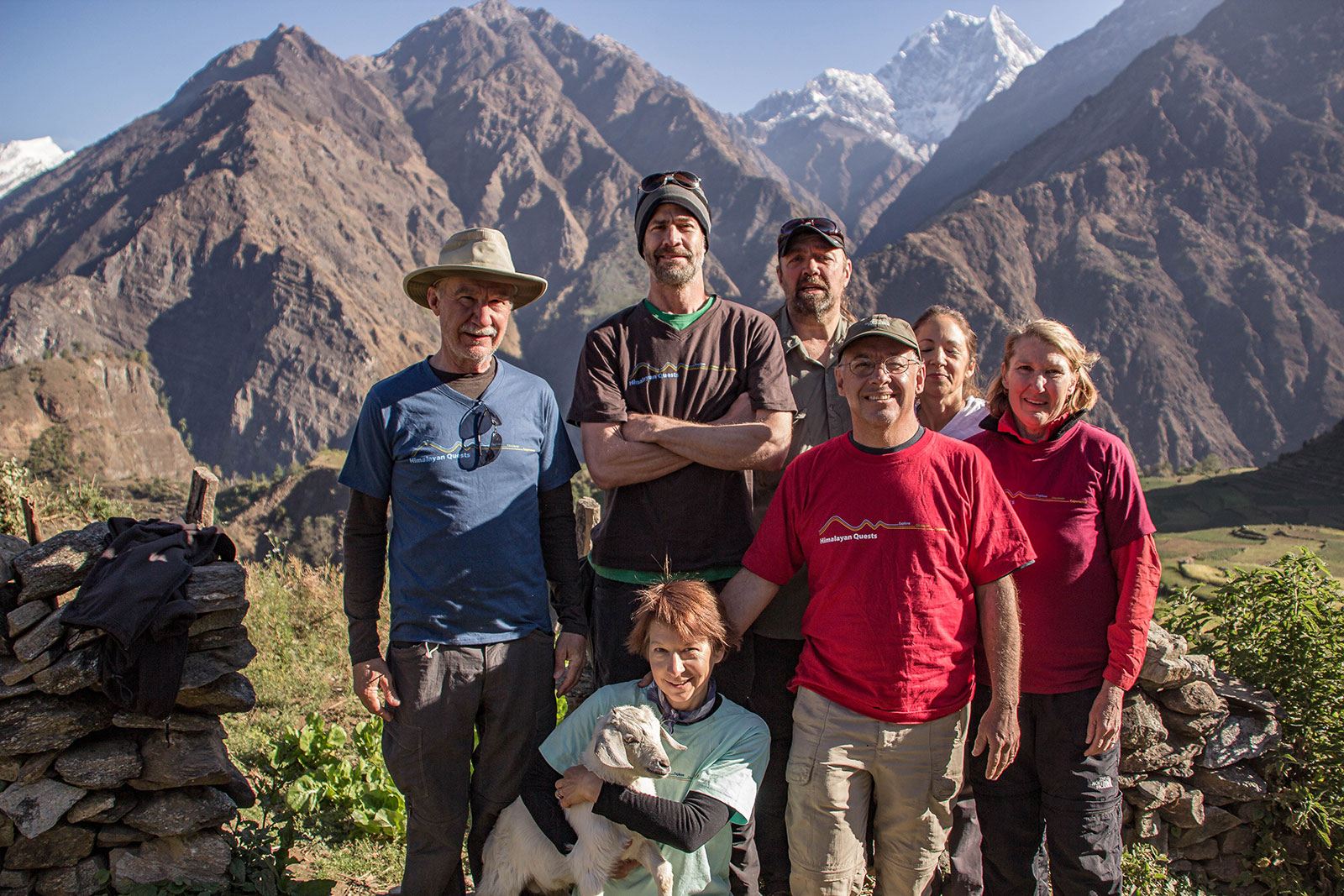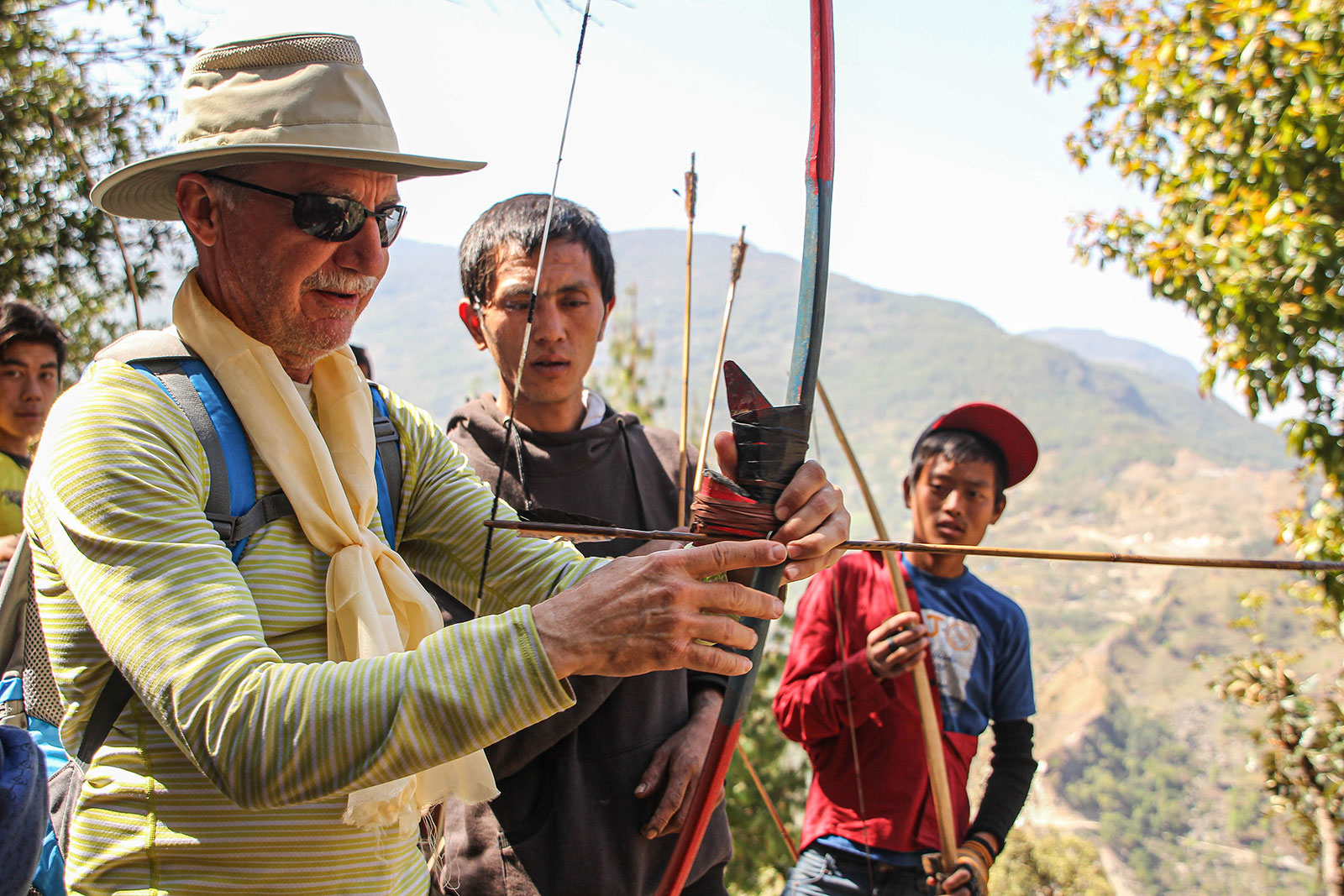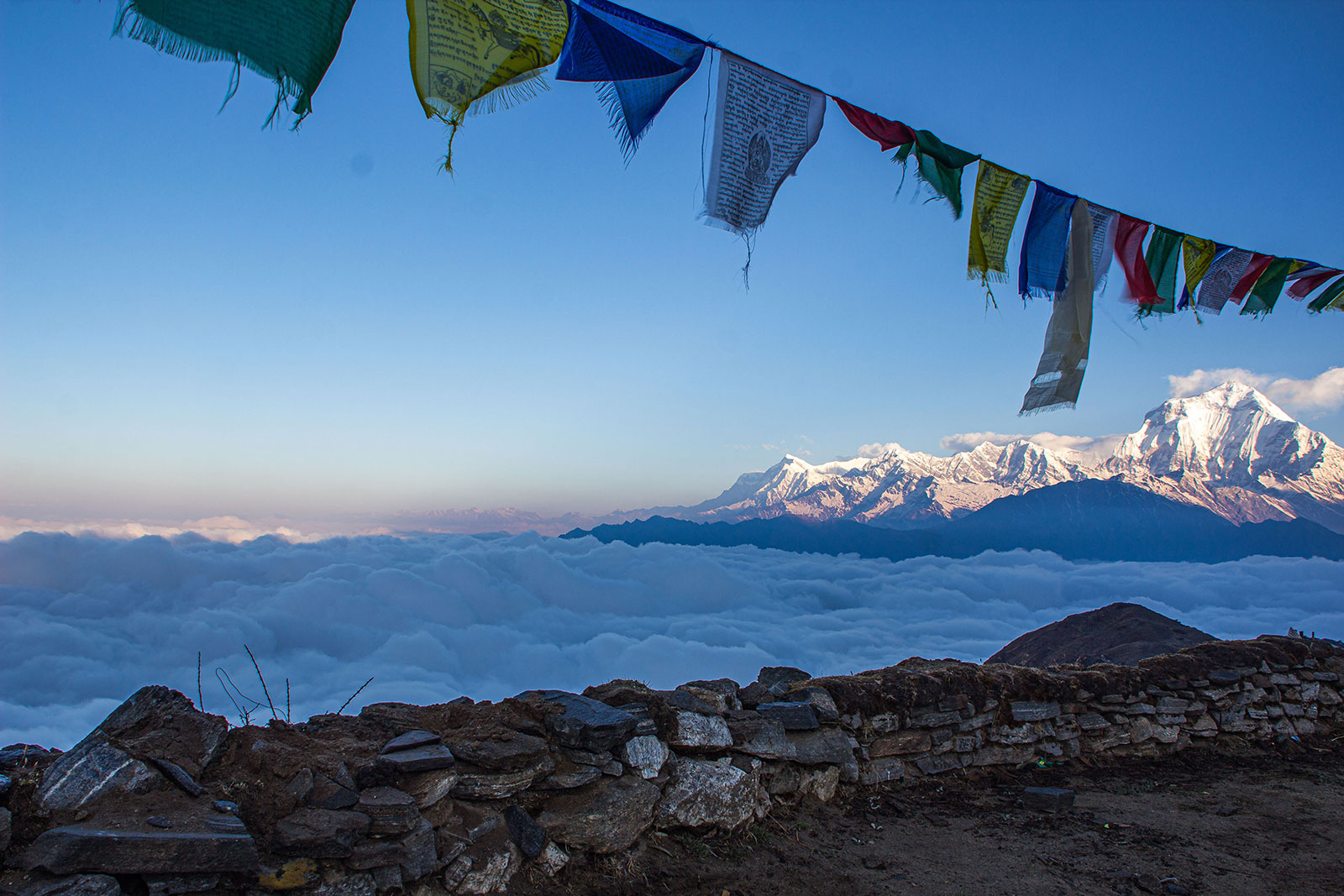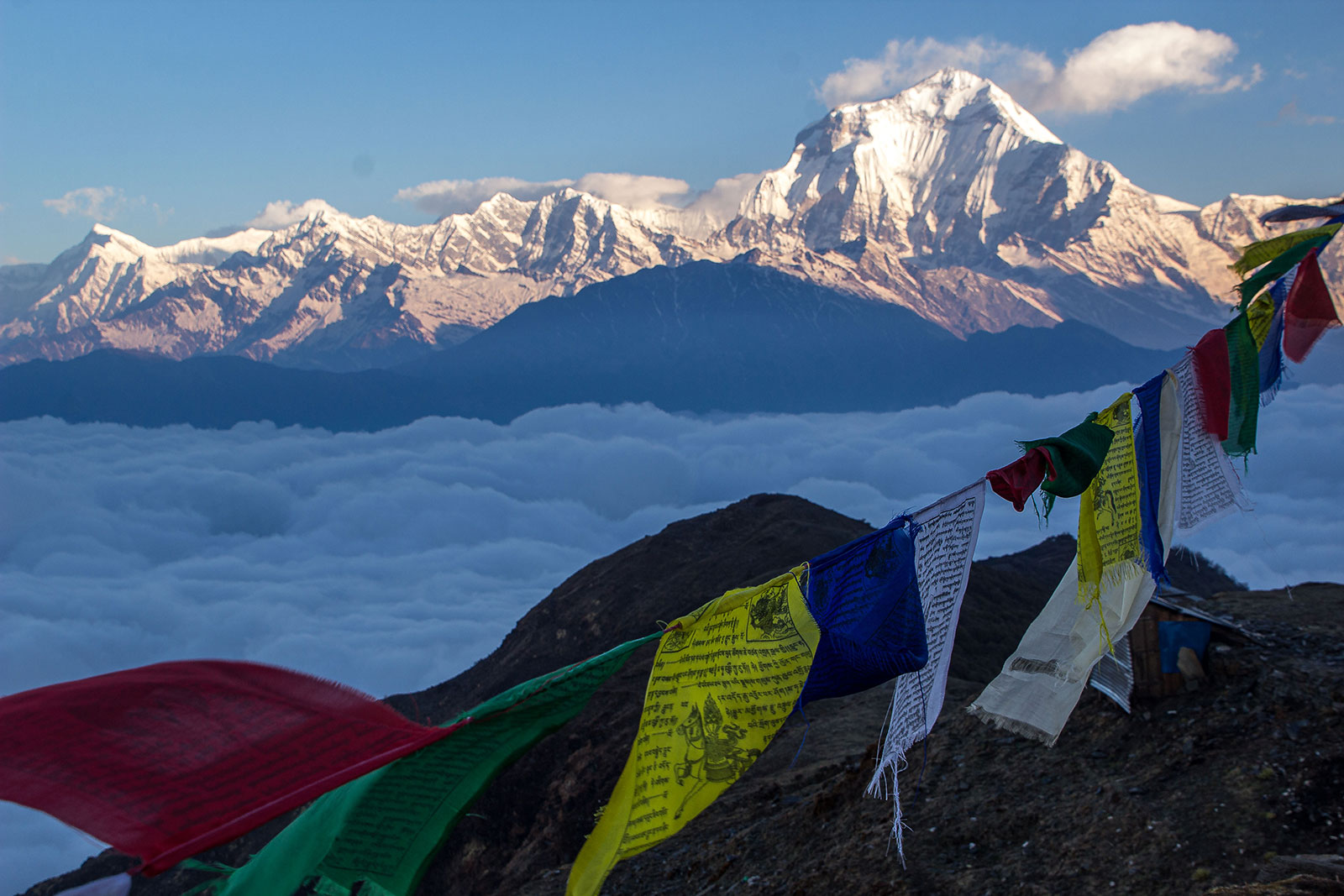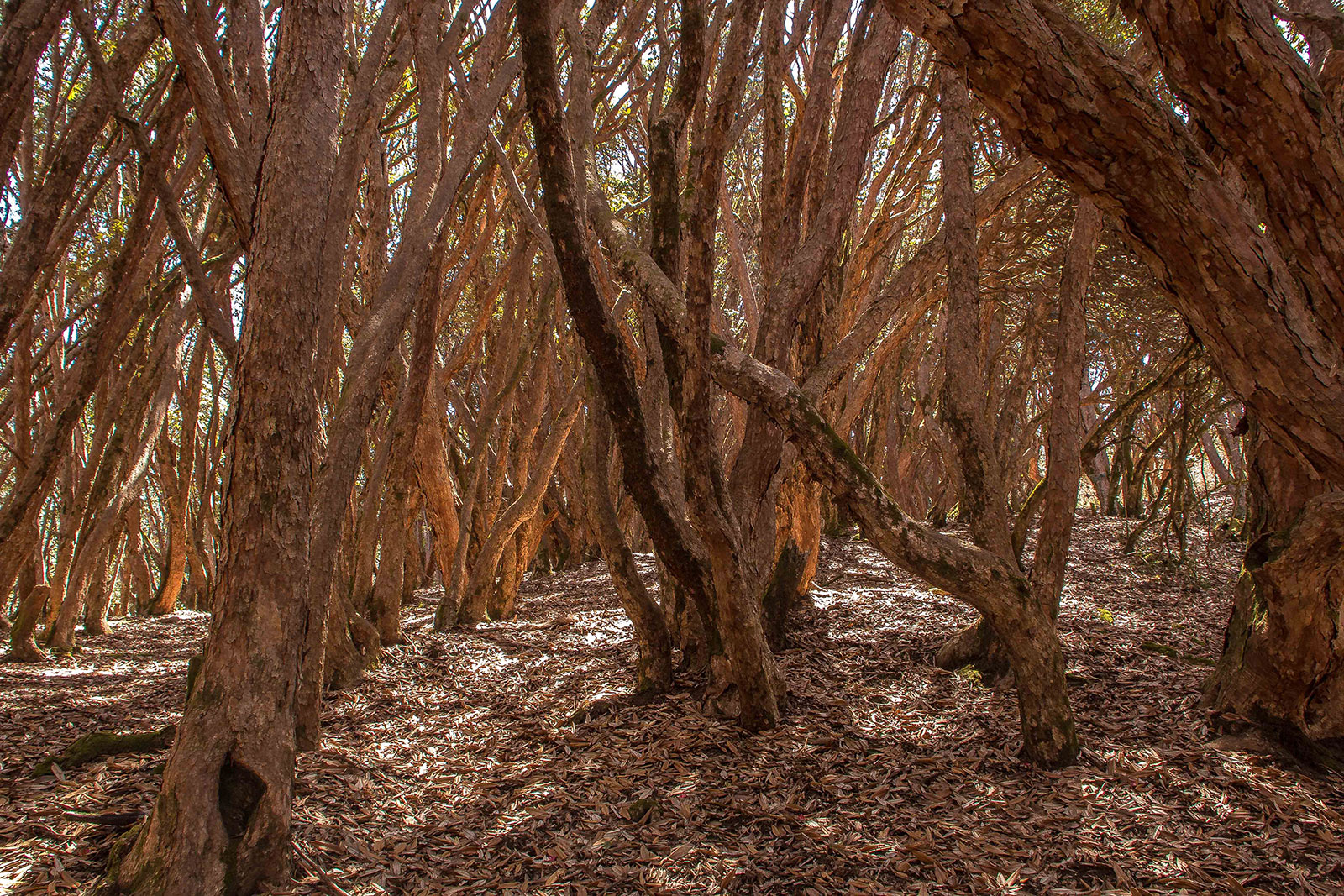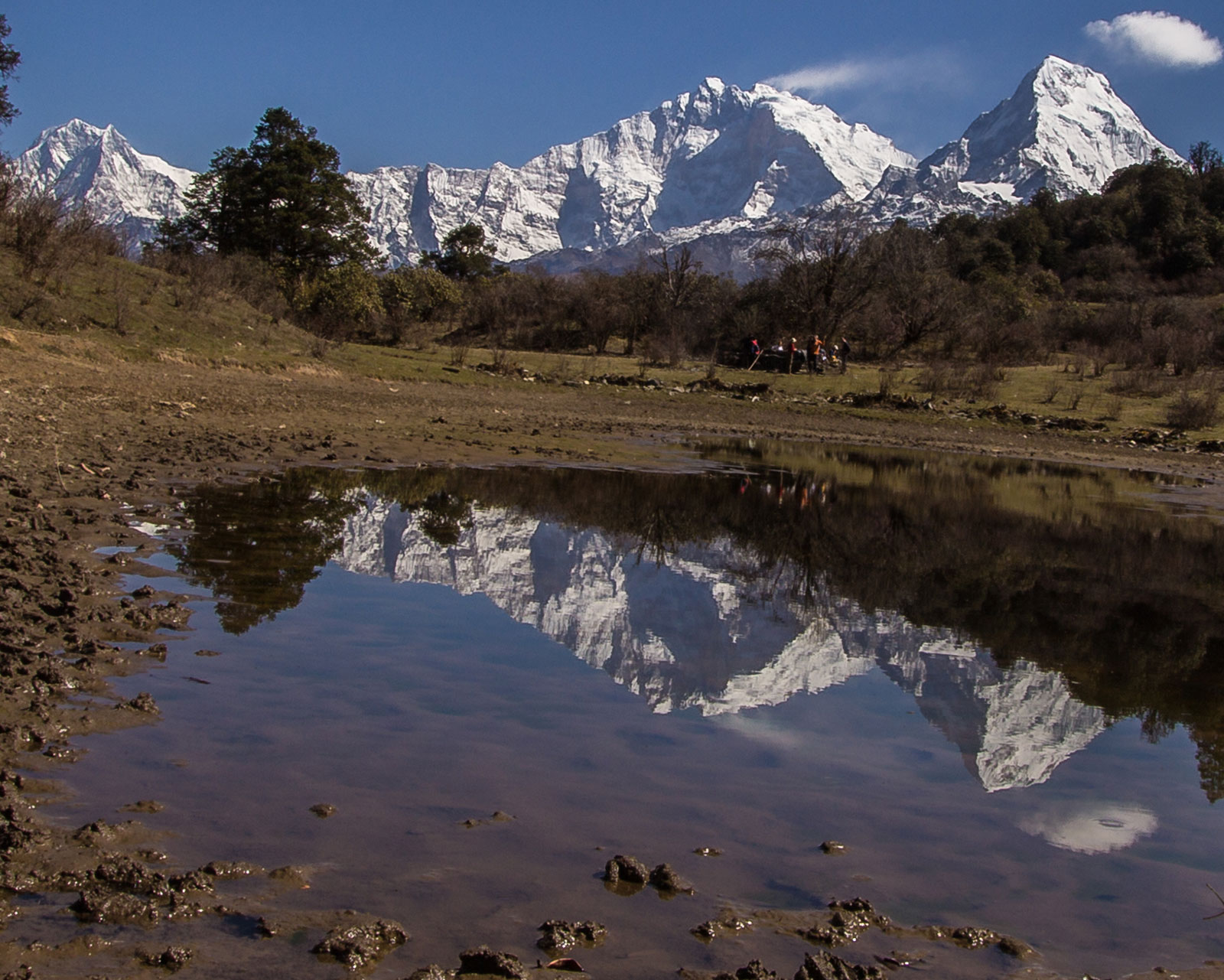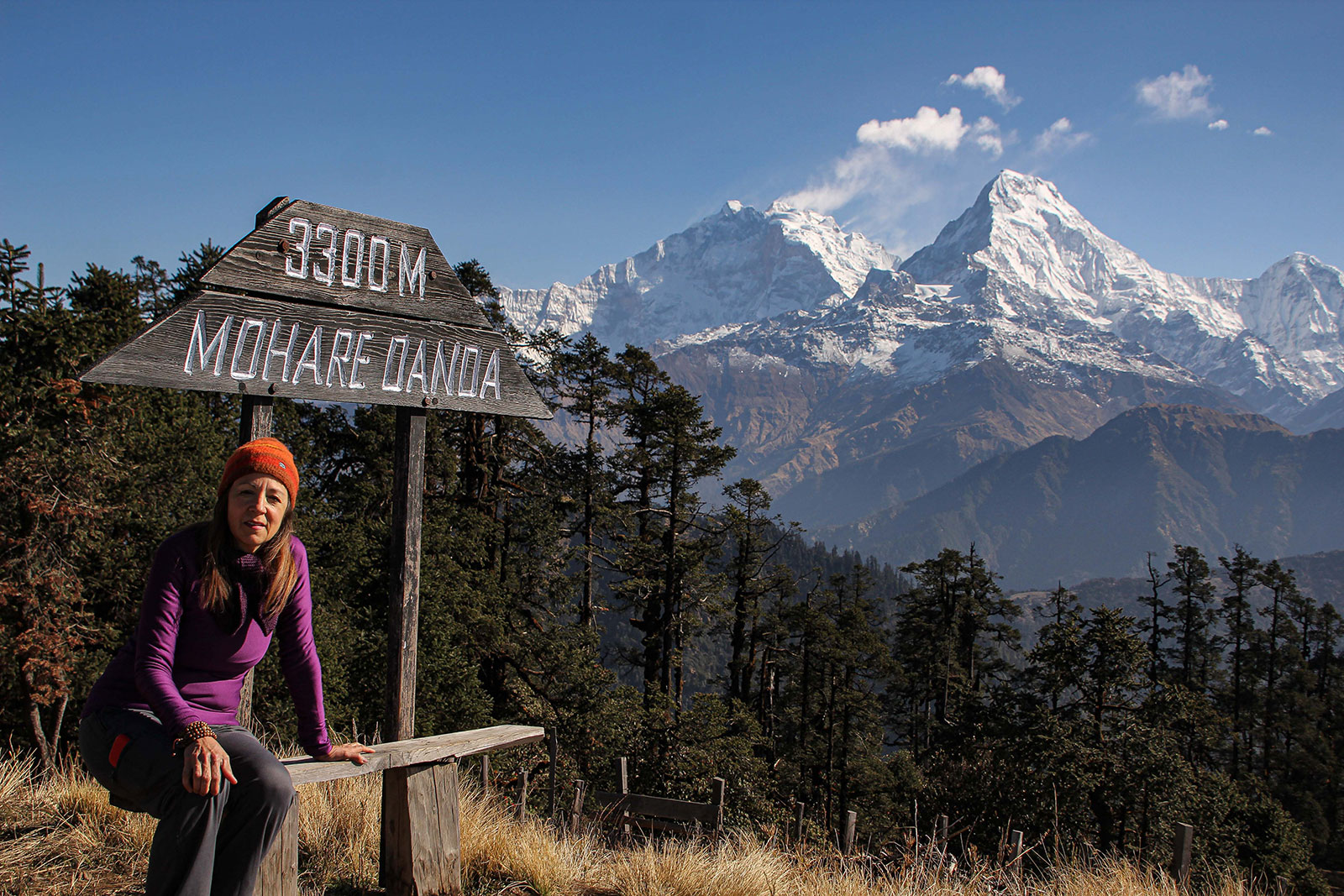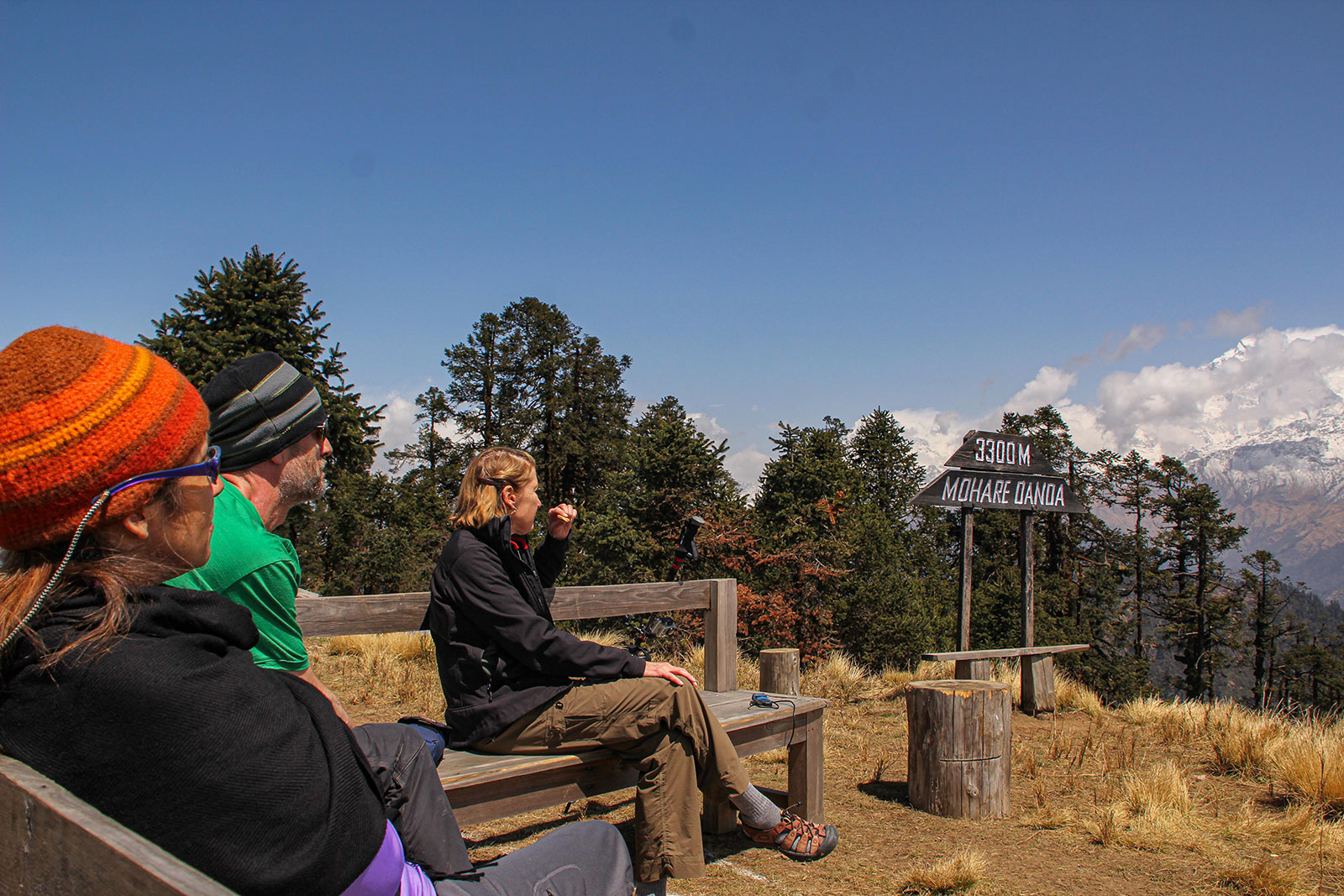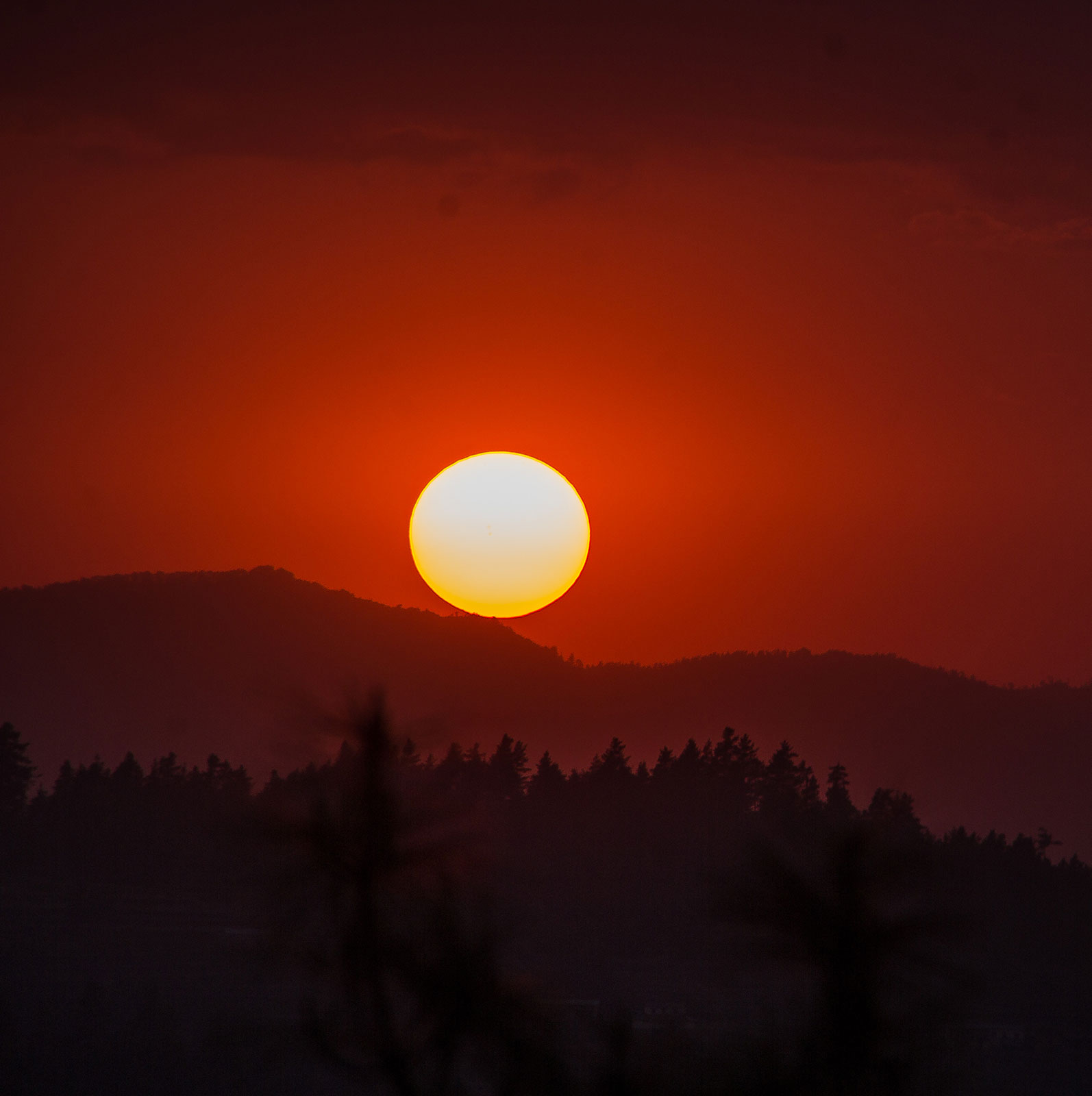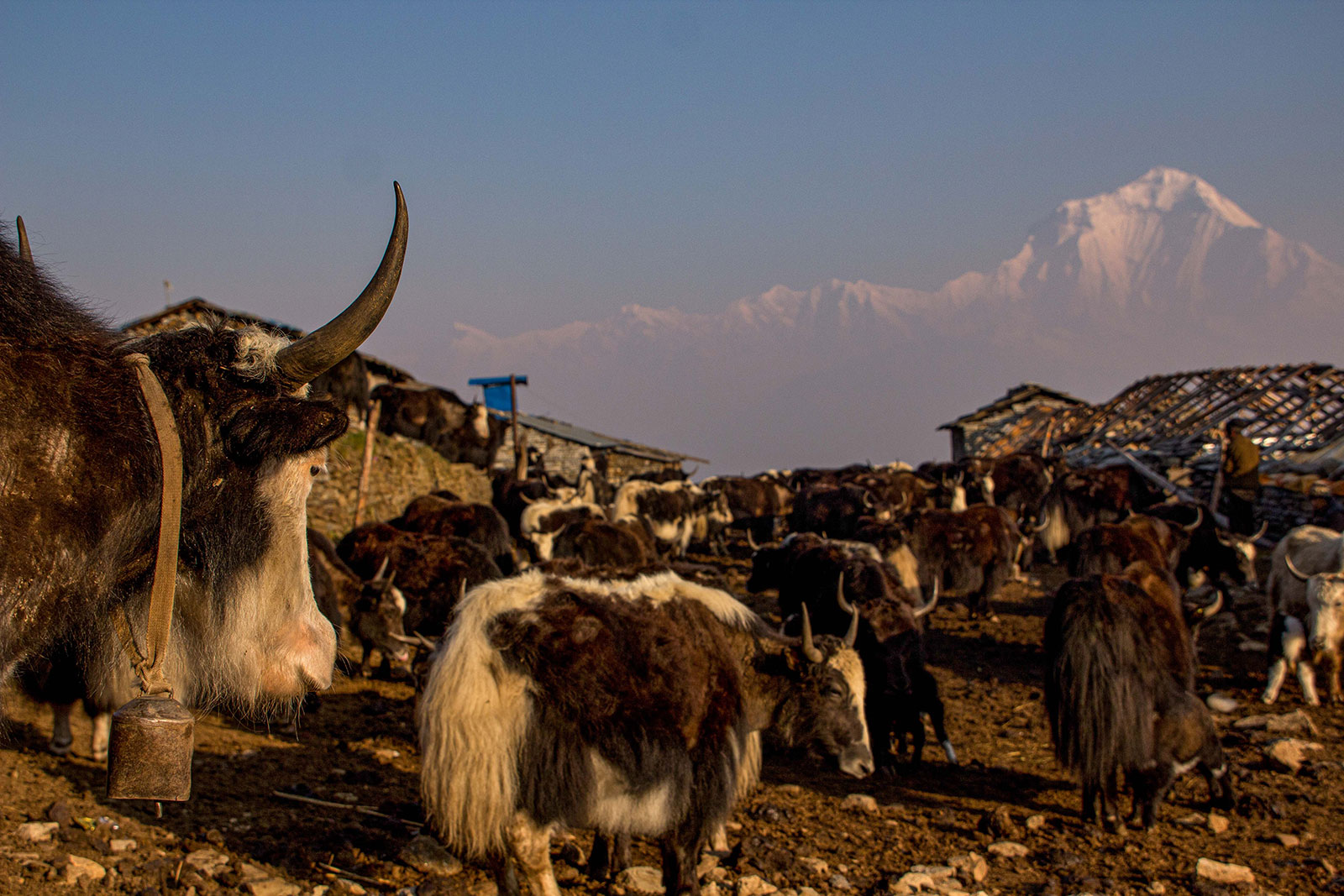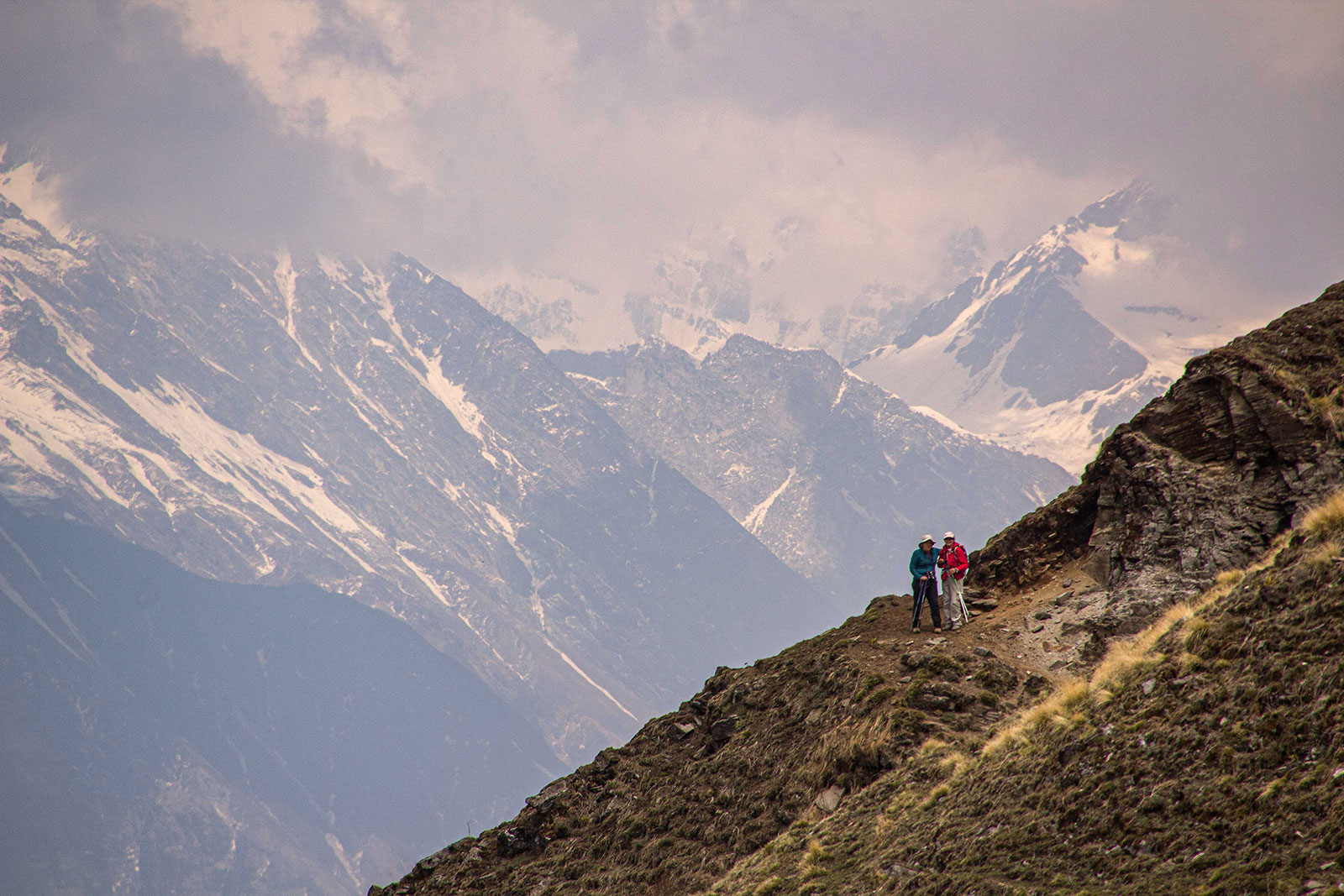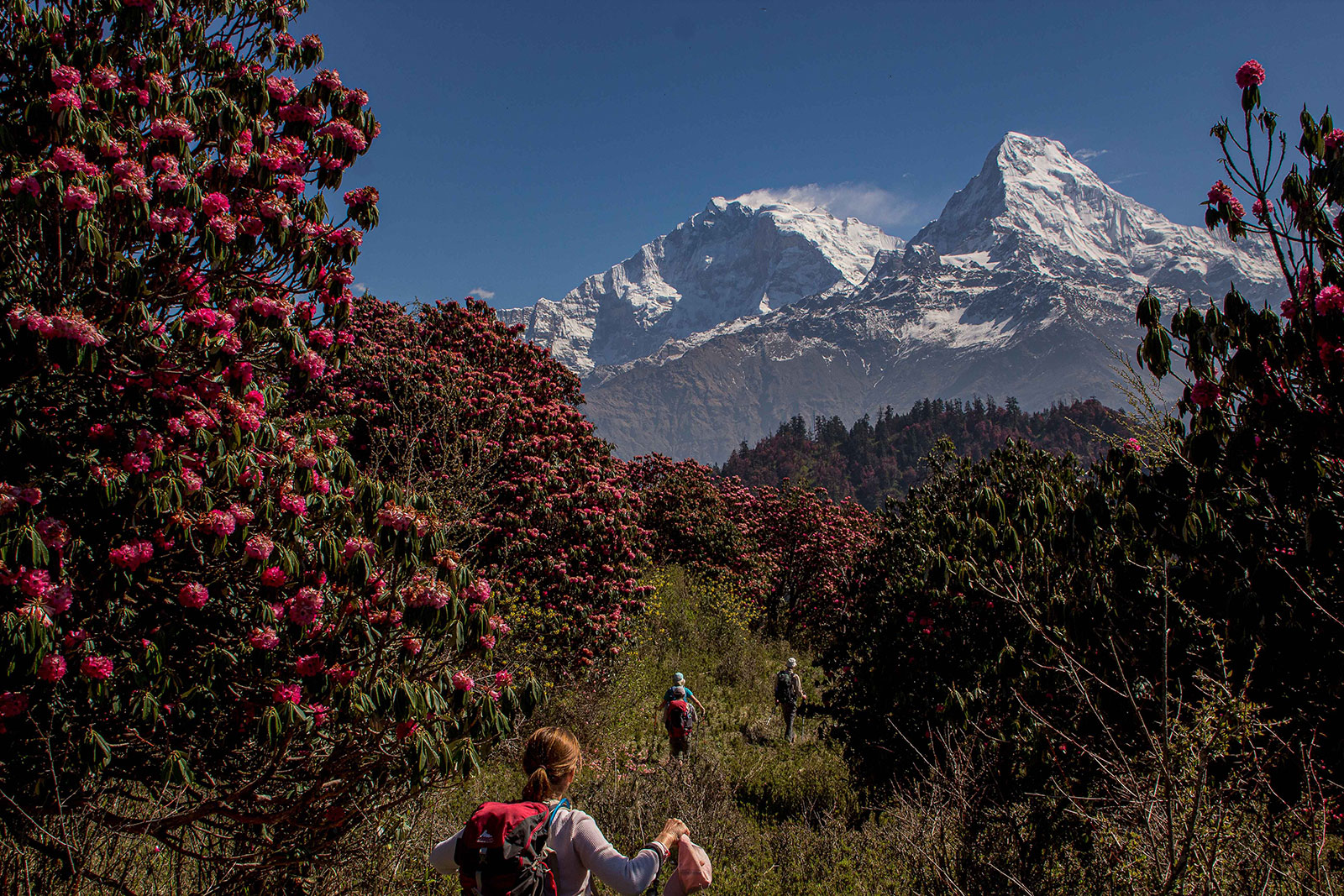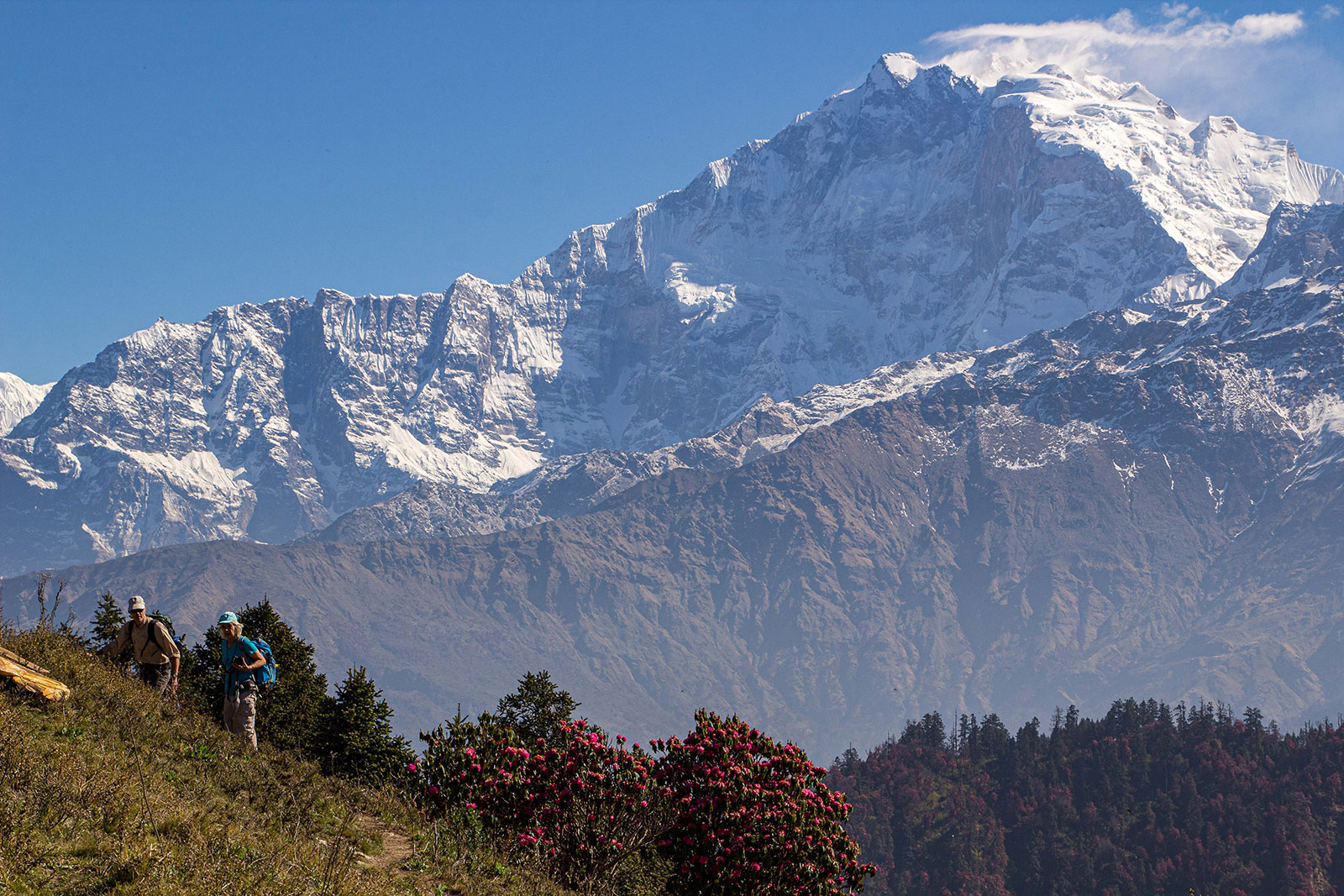Annapurna & Dhaulagiri Community Trek
Annapurna & Dhaulagiri Community Trek
DAYS
12
DIFFICULTY
Moderate
MAX ALTITUDE
4,500 M
ACCOMODATION
Community Lodges/ Teahouses/ Homestays
DAYS
13
DIFFICULTY
Moderate/ Strenuous
MAX ALTITUDE
4500 M
ACCOMMODATION
Community Lodges/ Tea House/ Homestay
Trip Overview
The Annapurna region of Nepal is a land so beautiful it has long been the ultimate trekking dream for hikers. Here, the sacred peaks of Annapurna, Machhapuchhre and Dhaulagiri, shining with snow year round, tower over ancient rhododendron forests, icy rivers and temperate jungles where tigers still roam. Plenty of trekkers come here for all this beauty – but few stray off the tourist routes. This trek will take you to off-the-beaten-track villages, where you will stay in village communities, sometimes even in people’s homes, giving you first hand experience of the real Nepal.
Along the way we can visit a village-weaving workshop, paper making workshop and cheese factory. We will spend a night at a yak farming project on the flanks of Annapurna range. The high point of this trek (quite literally) is a visit to the sacred Khayer Lake (4,500m) surrounded with shrines and the peak of Annapurna towering above.
This is a trek for those with a real sense of adventure, who are happy to embrace basic living conditions in order to experience rural, mountain people’s life in Nepal. This trek can be qualified as moderate, with occasional strenuous days and thus a reasonable level of fitness is required.
Accommodation on this trek is basic and on a shared basis, with little opportunity to wash either yourselves or your clothes, unless you wish to brave the cold communal village tap! A set of well-worn hiking boots, with a few pairs of good hiking socks are an absolute necessity. No technical experience or mountaineering gear is necessary. While porters will carry the majority of your luggage, you will need to bring a durable daypack to carry necessary items for quick access during the trek, such as water, toilet paper, camera, a warm layer, snacks etc. A full kit list will be sent to you upon confirmation of your participation on the trek.
Day 1 : Trek briefing and preparation day
Day 2 : Fly to Pokhara (30 mins). Drive to Beni (817) approx 3 hours
Day 3 : Trek Beni to Banskharka (1,526m), approx 3-4 hours
Day 4 : Trek Banskharka to Nagi (2,320m), approx 5-6 hours
Day 5 : Trek Nagi – Mohare Danda (3,320m), approx 6 hours
Day 6 : Trek Mohare Dada to Swanta (2,300m), approx 7-8 hours
Day 7 : Trek Swanta to Khopra (3,660m), approx 7-8 hours
Day 8 : Rest day in Khopra or optional day hike to Khyer Lake (4,500m)
Day 9 : Trek Khopra to Paudwar (2,000m), approx 6 hours
Day 10 : Trek Paudwar to Tatopani (1,190m), approx 3 hours
Day 11 : Drive Tatopani to Pokhara, approx 5 hours
Day 12 : Pokhara to Kathmandu: Fly or drive to Kathmandu
Notes:
The trek itinerary is a guide only and may be subject to change at short notice
In order to preserve the remote nature of this trek, it is limited to a maximum of 12 trekkers
Day 1: Trek briefing and preparation
Day 2: Fly or drive from Kathmandu to Pokhara. After lunch in Pokhara we drive to Beni to the trek start point (3 hours). Overnight in Beni (817m) in a simple hotel, on the banks of the Kali Gandaki River.
Day 3: Beni (817m) to Banskharka (1,526m). 3-4 hours walk. We take it slowly and steadily, stopping often along the way, and are rewarded by our first spectacular views of the snow-capped mountains. It is an interesting walk through rural villages of different cultural communities. We will homestay in Banskharka.
Day 4: Banskharka (1,526m) to Nagi (2,320m). 5-6 hours walk. Nagi itself is home to remote wireless internet pioneer Mahabir Pun. Overnight in a community lodge offering opportunities to see village development projects, visit a school or just explore the village.
Day 5: Nagi (2,320) to Mohare Danda (3,320m). 6 hours walk. This day we will walk through rhododendron forests. We will carry pack lunches as there are no settlements along the way. You will get to see lots of bird life and maybe some wild animal as well. From this spot you will get to see views of the Dhaulagiri and Annapurna ranges.
Day 6: Mohare Dada (3,320m) to Swanta (2,300m). 7-8 hours walk. We depart Swanta through a giant rhododendron forest. We then cross the Annapurna Circuit route at Phalate and ascend to Swanta where we overnight in a community lodge.
Day 7: Swanta (2,300m) to Khopra (3,660m). 7-8 hours walk. A hard, but beautiful climb through lush forests. As we near the tree line, we may see yaks from a local Village Development Committee yak farming project. Once we near Khopra we should be treated with magnificent panoramic views of Annapurna South, Baraha Shikhar, Nilgiri, Dhaulagiri and Gurja Himal. Overnight in a community lodge with the yak farmer who also manages the relay station for the villages’ wireless network.
Day 8: Rest day in Khopra or optional day hike. We depart early for the walk to Khayer Lake at 4,500m. This high altitude lake is visited only rarely by pilgrims and is seldom seen by outsiders. This is a long, hard day, usually about 10/11 hours walking for the return trip. We will however be rewarded for our efforts by magnificent mountain views along our route, and the opportunity to see this beautiful, often mirror-calm lake surrounded by mountains and shrines. Annapurna is right above us.
Day 9: Khopra (3,600m) to Paudwar (2,000m). 6 hours walk. A long descent, with inspiring views over Dhaulagiri and the Kali Gandaki River valley – the deepest gorge on earth. Overnight homestay in Paudwar village, a Magar village with about 350 houses. In Paudwar we can visit a cheese-making scheme, unique in this area.
Day 10: Paudwar (2,000m) to Tatopani (1,190m). 3 hours walk. An easy descent down to the Kaligandaki River and walk along the river to get to Tatopani for lunch. At Tatopani you can soak your weary legs in the famous hot springs. This town is busier than any other places we pass through, as this is on a main Annapurna Circuit trail. You’ll be able to contrast this to the places you’ve seen, buy things in the bazaar – and more importantly, enjoy a hot shower.
Day 11: Tatopani to Pokhara. We will take a jeep/bus from Taopani to Beni and then retrace our journey back to Pokhara. Altogether it’s about 5 hours drive. Over night in Pokhara.
Day 12: Pokhara to Kathmandu: Fly or drive to Kathmandu
Notes:
The trek itinerary is a guide only and may be subject to change at short notice
In order to preserve the remote nature of this trek, it is limited to a maximum of 12 trekkers
Himalayan Quests uses a layering system where different pieces of clothing are worn together or separately to achieve optimum body temperature control. The upper body garments listed here are either synthetic or merino wool garments that retain their insulating properties when wet, or nylon or Gore-Tex layers which help prevent heat loss by cutting wind, rain, and snow.
This is a guideline only
| UPPER BODY LAYERS | ||
| Equipment | Quantity | Comments |
| T-Shirts – walking | 2 | We recommend merino wool, Capilene or other synthetic fabric as they wick away the moisture and dry quickly. No cotton. |
| T-shirt – sleeping | 1 | This can be cotton |
| Base layers (ie thermal top) | 1 | Lightweight or mid-weight long-sleeved t-shirt of merino wool, polyester, Capilene, or Polartec power dry |
| Top insulating Layers | 1 | Mid-weight fleece that can be worn over other layers |
| Fleece Vest | 1 | |
| Rain jacket | 1 | |
| Down Jacket | 1 | |
| LOWER BODY LAYERS | ||
| Equipment | Quantity | Comments |
| Underwear | Sufficient for the trek (remember you can wash them) | |
| Thermal long johns/long underwear | 1 | |
| Trekking Trousers | 2 | Lightweight quick-dry trousers (no cotton). Zip offs are good |
| Evening/sleeping trousers | 1 optional | 1 pair of lightweight tracksuit bottoms (sweat pants) or yoga style trousers for evening wear and sleeping in. No jeans. |
| Hiking Shorts | 1 | If no zip-off trousers. Below the knee for ladies |
| Rain Pants | 1 | |
| PACKS & BAGS | ||
| Equipment | Quantity | Comments |
| Day pack | 1 | Approx. 35ltrs. HQ will provide you with a duffle bag for your trekking gear |
| Sleeping bag with compression sack | 1 | Minimum 3 season |
| Sleeping bag liner | 1 | Optional |
| FOOTWEAR | ||
| Equipment | Quantity | Comments |
| Hiking boots | 1 | Must be well worn and comfortable with ankle support |
| Socks | 3 | |
| Flip flops/Camp shoes | 1 | Lightweight for evening use |
| MISCELLANEOUS ITEMS | ||
| Equipment | Quantity | Comments |
| Water bottles | 2 | One liter each, Nalgene or Sig style or a bladder if preferred |
| Water purification drops | 1 | Cheap and easy to buy in Kathmandu (Piyus) |
| Lip Balm | 1 | With SPF factor |
| Sunscreen | 1 | We recommend SPF 30 or greater |
| Mosquito repellent | 1 | |
| Personal first aid kit | 1 | To include any prescribed medications |
| Sunglasses | 1 | |
| Bandana/Buff | 1 | Useful for a variety of purposes. |
| Flashlight /head torch | 1 | Head torch is best as it leaves your hands free + extra batteries |
| Travel towel | 1 | Lightweight and compact |
| Wash kit | Travel size items for the trek & eco friendly if possible | |
| Instant Hand Sanitizer | 1 | Alcohol-based for keeping hands clean |
| Sun hat | 1 | |
| Warm hat | 1 | |
| Gloves | 1 | |
| Trekking poles | Optional | |
| Trekking snacks | Good selection available in KTM | |
| Camera | With charger &/or extra batteries | |
| Toilet paper & rubbish bag | ||
| Book/journal | ||
| Pack of cards/travel game | 1 | For evening entertainment |
| Passport photos | Always useful and a must-have if you want a local sim card | |
| Photocopies of all your important documents | ||
| A great sense of humor & a positive attitude | Essential – don’t come without it!! J | |
Your trek cost includes:
- Pre-trip advice and detailed information
- Expert trip leadership and motivated staff for the duration of the trek
- Airport transfers in Nepal (where applicable)
- 2 nights accommodation pre-trek & 1-night post-trek in Kathmandu
- 1-night accommodation pre or post-trek in Pokhara (where applicable)
- Transportation to and from trek start and finish for you and your trekking team (different budget options available)
- Basic teahouse/lodge/camping accommodation during the trek on a twin sharing basis
- During the trek all meals on a full board basis (breakfast, lunch, and dinner) to include tea/coffee during the meals, but excluding any drinks outside of the meal times
- All permits, conservation area, and restricted area fees
- Porters
- Insurance and equipment for Nepali staff
- Rescue assistance
- Group medical kit
Your trek cost does NOT include:
- International flights to and from Kathmandu, Nepal
- Visa for Nepal
- Travel insurance (insurance to include evacuation is mandatory. Please make sure you are covered to the correct altitude)
- Personal expenses such as fizzy drinks, chocolate, gifts, snacks, hot showers during the trek, etc.
- Meals unless specified
- Sightseeing
- Gratuities
- Excess baggage on internal flights
- Charges incurred as a result of delays beyond the control of Himalayan Quests
This trek emphasizes:
- Respect of the local people
- Respect of their living habits, customs, and religion
- Use of local community lodges and people’s homes for lodging and local products for eating
- Protecting the natural and human habitat
Day 1 : Trek briefing and preparation day
Day 2 : Fly to Pokhara (30 mins). Drive to Beni (817) approx 3 hours
Day 3 : Trek Beni to Banskharka (1,526m), approx 3-4 hours
Day 4 : Trek Banskharka to Nagi (2,320m), approx 5-6 hours
Day 5 : Trek Nagi – Mohare Danda (3,320m), approx 6 hours
Day 6 : Trek Mohare Dada to Swanta (2,300m), approx 7-8 hours
Day 7 : Trek Swanta to Khopra (3,660m), approx 7-8 hours
Day 8 : Rest day in Khopra or optional day hike to Khyer Lake (4,500m)
Day 9 : Trek Khopra to Paudwar (2,000m), approx 6 hours
Day 10 : Trek Paudwar to Tatopani (1,190m), approx 3 hours
Day 11 : Drive Tatopani to Pokhara, approx 5 hours
Day 12 : Pokhara to Kathmandu: Fly or drive to Kathmandu
Notes:
The trek itinerary is a guide only and may be subject to change at short notice
In order to preserve the remote nature of this trek, it is limited to a maximum of 12 trekkers
Day 1: Trek briefing and preparation
Day 2: Fly or drive from Kathmandu to Pokhara. After lunch in Pokhara we drive to Beni to the trek start point (3 hours). Overnight in Beni (817m) in a simple hotel, on the banks of the Kali Gandaki River.
Day 3: Beni (817m) to Banskharka (1,526m). 3-4 hours walk. We take it slowly and steadily, stopping often along the way, and are rewarded by our first spectacular views of the snow-capped mountains. It is an interesting walk through rural villages of different cultural communities. We will homestay in Banskharka.
Day 4: Banskharka (1,526m) to Nagi (2,320m). 5-6 hours walk. Nagi itself is home to remote wireless internet pioneer Mahabir Pun. Overnight in a community lodge offering opportunities to see village development projects, visit a school or just explore the village.
Day 5: Nagi (2,320) to Mohare Danda (3,320m). 6 hours walk. This day we will walk through rhododendron forests. We will carry pack lunches as there are no settlements along the way. You will get to see lots of bird life and maybe some wild animal as well. From this spot you will get to see views of the Dhaulagiri and Annapurna ranges.
Day 6: Mohare Dada (3,320m) to Swanta (2,300m). 7-8 hours walk. We depart Swanta through a giant rhododendron forest. We then cross the Annapurna Circuit route at Phalate and ascend to Swanta where we overnight in a community lodge.
Day 7: Swanta (2,300m) to Khopra (3,660m). 7-8 hours walk. A hard, but beautiful climb through lush forests. As we near the tree line, we may see yaks from a local Village Development Committee yak farming project. Once we near Khopra we should be treated with magnificent panoramic views of Annapurna South, Baraha Shikhar, Nilgiri, Dhaulagiri and Gurja Himal. Overnight in a community lodge with the yak farmer who also manages the relay station for the villages’ wireless network.
Day 8: Rest day in Khopra or optional day hike. We depart early for the walk to Khayer Lake at 4,500m. This high altitude lake is visited only rarely by pilgrims and is seldom seen by outsiders. This is a long, hard day, usually about 10/11 hours walking for the return trip. We will however be rewarded for our efforts by magnificent mountain views along our route, and the opportunity to see this beautiful, often mirror-calm lake surrounded by mountains and shrines. Annapurna is right above us.
Day 9: Khopra (3,600m) to Paudwar (2,000m). 6 hours walk. A long descent, with inspiring views over Dhaulagiri and the Kali Gandaki River valley – the deepest gorge on earth. Overnight homestay in Paudwar village, a Magar village with about 350 houses. In Paudwar we can visit a cheese-making scheme, unique in this area.
Day 10: Paudwar (2,000m) to Tatopani (1,190m). 3 hours walk. An easy descent down to the Kaligandaki River and walk along the river to get to Tatopani for lunch. At Tatopani you can soak your weary legs in the famous hot springs. This town is busier than any other places we pass through, as this is on a main Annapurna Circuit trail. You’ll be able to contrast this to the places you’ve seen, buy things in the bazaar – and more importantly, enjoy a hot shower.
Day 11: Tatopani to Pokhara. We will take a jeep/bus from Taopani to Beni and then retrace our journey back to Pokhara. Altogether it’s about 5 hours drive. Over night in Pokhara.
Day 12: Pokhara to Kathmandu: Fly or drive to Kathmandu
Notes:
The trek itinerary is a guide only and may be subject to change at short notice
In order to preserve the remote nature of this trek, it is limited to a maximum of 12 trekkers
Trekking Gear List
Himalayan Quests uses a layering system where different pieces of clothing are worn together or separately to achieve optimum body temperature control. The upper body garments listed here are either synthetic or merino wool garments which retain their insulating properties when wet, or nylon or Gore-Tex layers which help prevent heat loss by cutting wind, rain and snow.
THIS IS A GUIDELINE ONLY
UPPER BODY LAYERS
- T Shirts – walking 2 Merino wool, Capilene or other synthetic, wicking fabric. No cotton
- T-shirt – sleeping 1 Can be cotton
- Base layers 1 Light weight or mid weight thermal long sleeved t-shirt
- Top insulating Layers 1 Mid weight fleece that can be worn over other layers
- Fleece Vest 1
- Rain jacket 1
- Down jacket 1
LOWER BODY LAYERS
- Underwear Sufficient for trek (remember you can wash them)
- Thermal long underwear 1
- Trekking Trousers 2 Lightweight quick dry trousers (no cotton). Zip-offs are good
- Hiking Shorts 1 If no zip-off trousers. Below the knee for ladies
- Rain Pants 1
PACKS & BAGS
- Day pack 1 35ltrs. HQ will provide you with a duffle bag for your trekking gear
- Sleeping bag & compression sack 1 Minimum 3 season
FOOTWEAR
- Hiking boots 1 Must be well worn and comfortable with ankle support
- Socks 3 or 4
- Flip flops/Camp shoes 1 Lightweight for evening use
MISCELLANEOUS ITEMS
- Water bottles 2 One litre each, Nalgene or Sig style or a bladder if preferred
- Water purification drops Cheap and easy to buy in Kathmandu (Piyus)
- Sunscreen We recommend SPF 30 or greater
- Lip Balm With SPF factor
- Personal first aid kit To include any prescribed medications
- Sunglasses
- Bandana/Buff
- Flash light /head torch Head torch is best as it leaves your hands free + extra batteries
- Travel towel Lightweight and compact
- Wash kit Travel size items for the trek & eco friendly if possible
- Hand Sanitizer Alcohol-based for keeping hands clean
- Sun hat
- Warm hat
- Gloves
- Trekking poles Optional, but advised if you have dodgy knees
- Toilet paper & rubbish bag
- Trekking snacks Good selection available in KTM
- Camera With charger &/or extra batteries
- Book/journal
- Pack of cards/travel game For evening entertainment
- Mosquito repellent
- Passport photos Always useful and a must have if you want a local sim card
- Photocopies of all your important documents
- A great sense of humour & positive attitude Essential – don’t come without it!! J
Much of the above equipment can be bought cheaply in Kathmandu. You do not need to spend a fortune on gear.
Your trek cost includes:
- Pre-trip advice and detailed information
- Expert trip leadership and motivated staff for the duration of the trek
- Airport transfers in Nepal (where applicable)
- 2 nights accommodation pre-trek & 1-night post-trek in Kathmandu
- 1-night accommodation pre or post-trek in Pokhara (where applicable)
- Transportation to and from trek start and finish for you and your trekking team (different budget options available)
- Basic teahouse/lodge/camping accommodation during the trek on a twin sharing basis
- During the trek all meals on a full board basis (breakfast, lunch, and dinner) to include tea/coffee during the meals, but excluding any drinks outside of the meal times
- All permits, conservation area, and restricted area fees
- Porters
- Insurance and equipment for Nepali staff
- Rescue assistance
- Group medical kit
Your trek cost does NOT include:
- International flights to and from Kathmandu, Nepal
- Visa for Nepal
- Travel insurance (insurance to include evacuation is mandatory. Please make sure you are covered to the correct altitude)
- Personal expenses such as fizzy drinks, chocolate, gifts, snacks, hot showers during the trek, etc.
- Meals unless specified
- Sightseeing
- Gratuities
- Excess baggage on internal flights
- Charges incurred as a result of delays beyond the control of Himalayan Quests
This trek emphasizes:
- Respect of the local people
- Respect of their living habits, customs, and religion
- Use of local community lodges and people’s homes for lodging and local products for eating
- Protecting the natural and human habitat
Similar Trips
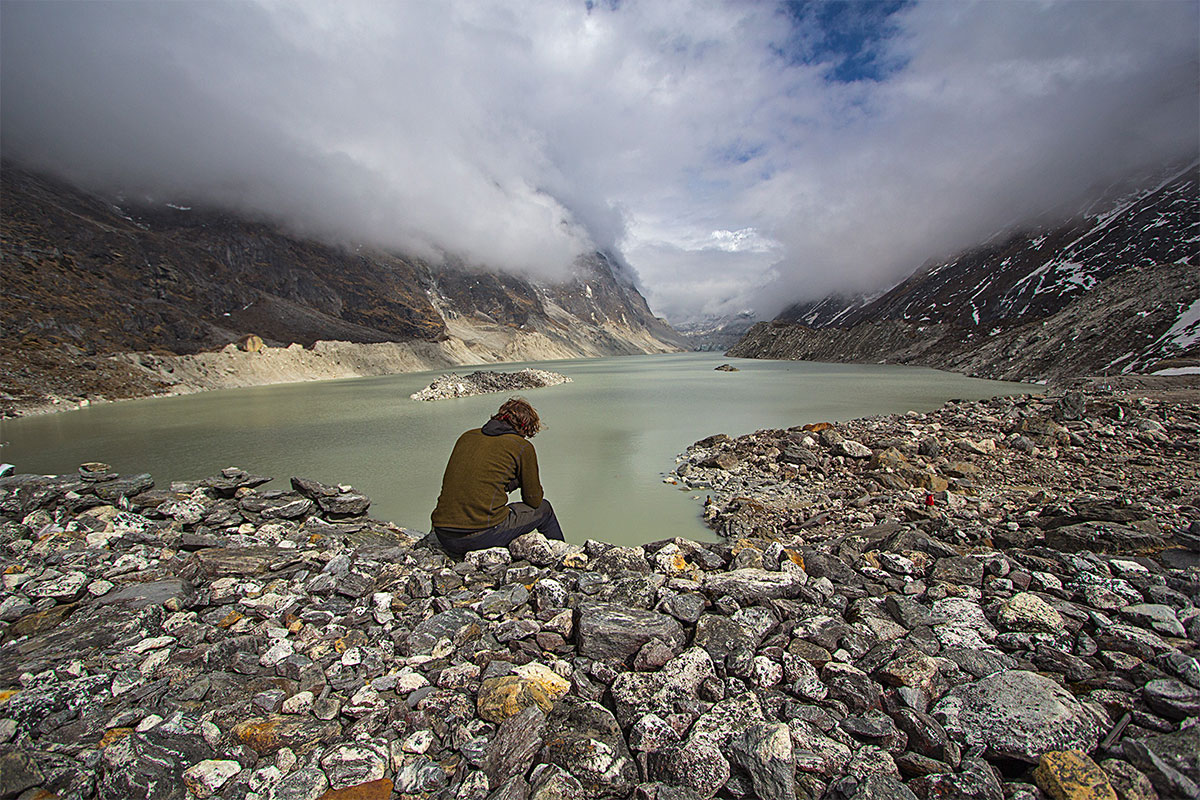
Rolwaling Valley Trek
12 Days
Although located in the popular Annapurna range, this camping trek takes you behind the Annapurna Circuit, away from the crowds and into an untouched world.

Annapurna & Dhaulagiri Community Trek
12 Days
This is a trek for those with a real sense of adventure, who are happy to embrace basic living conditions in order to experience rural, mountain people’s life in Nepal.
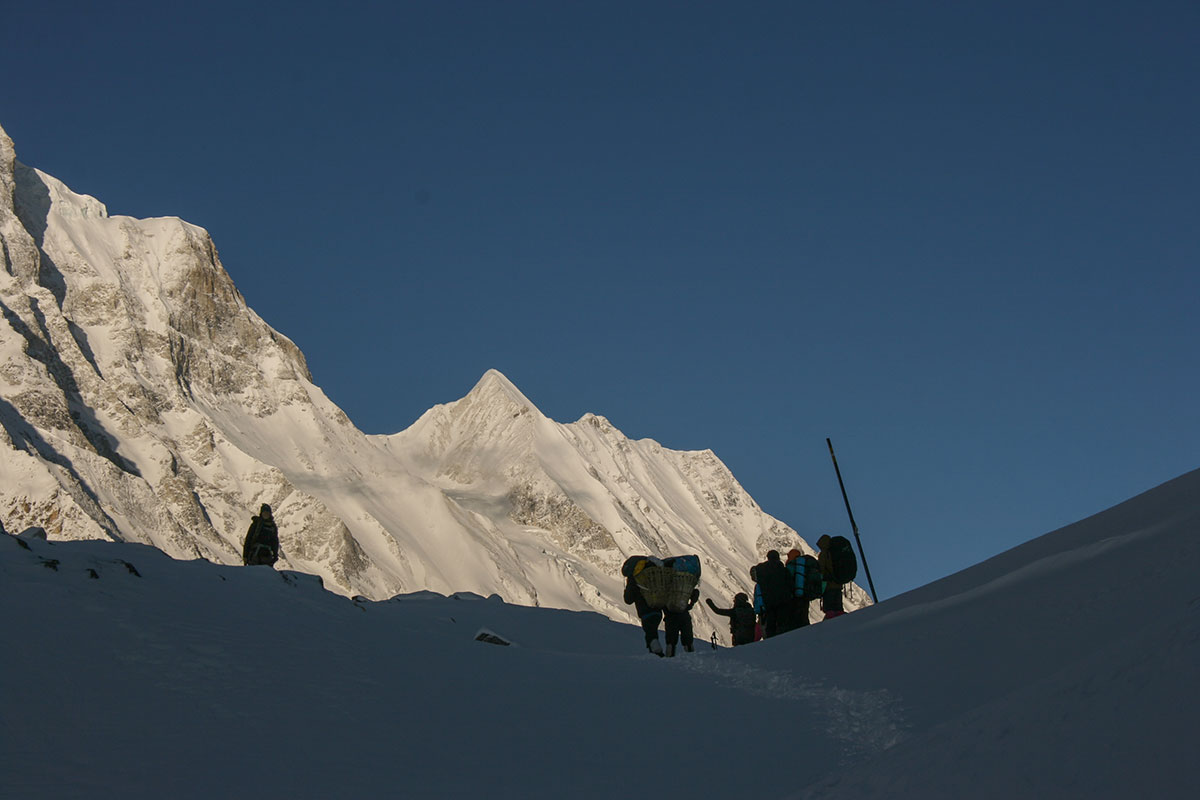
Langtang Valley Trek
9 Days
The Langtang Valley offers ancient forests, swift mountain streams, rugged rock, and snow-capped mountains, grassy meadows, glaciers and a chance to observe Tamang culture at close quarters.
CONTACT US
Let us help you plan the trip of your dreams
Address
GPO Box: 8974 CPC 437
Kathmandu, Nepal.
Nepal Govt. Registration
11881/424 1134/066
Phone
Our Team
Diaries
Featured Trips
Bespoke For You
CONTACT US
Let us help you plan the trip of your dreams
Address
GPO Box: 8974 CPC 437
Kathmandu, Nepal.
Nepal Govt. Registration
11881/424 1134/066
info@himalayanquests.com
Phone
+977 9849 141067

